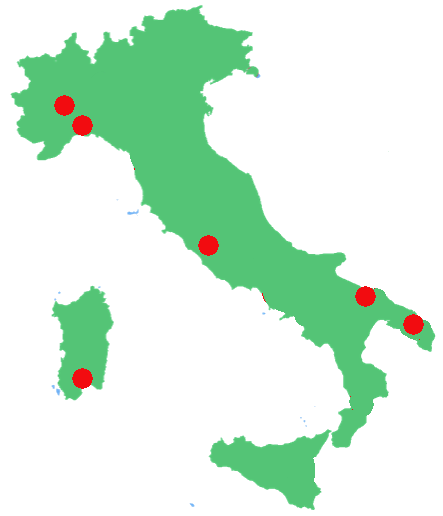Scientific activities of the various Research Units
Bari
-
The research of the node in Bari is focused on non-equilibrium statistical mechanics
and on the dynamical behavior of complex fluids and active matter.
General concepts like effective temperature and probability distributions
for fluctuations are studied in out of equilibrium systems and biological matter.
Complex and active fluids are investigated by Lattice Boltzmann
Methods.
Cholesteric and blue-phase liquid crystals,
binary mixtures with surfactant, self-propelled drops,
phase separating liquid-vapour mixtures are examples of the systems recently studied.
Cagliari
-
Microscopic swimmming, with particular interest in the exploitation of external means
(presence of an external flow, of thermal fluctuations, etc.) to aid propulsion.
The dynamics of a population in an external flows, especially as regards the role of demographic
fluctuations in the problem. Modelling of turbulence and turbulent transport by random fields.
Genova
-
Our research activity is focused on the transport of inertial particles both punctual
and with finite size. As far as the first case is concerned, the large-scale/long-time
transport of inertial particles of arbitrary mass density under gravity is a current subject
of investigation by means of a formal
renormalized multiple-scale perturbative expansion in the scale-separation parameter
between the carrier flow and the particle concentration field. In the case of finite
size particles, we use theory, experiments, and numerical simulations to investigate
locomotion of solid objects with protrusions (mimicking, e.g., hairs or plumes).
In a recent activity we showed that an object with a protrusion in a separated flow
drifts sideways by exploiting a symmetry-breaking instability similar to the instability
of an inverted pendulum. Our model explains why the straight position of an appendage
in a fluid flow is unstable and how it stabilizes either to the left or right of the
incoming flow direction.
Lecce
-
A common ground of research within the unit is Lagrangian Turbulence.
This implies addressing different issues such as: the buoyancy and heat
transport properties of the bubble compound in two-phase Rayleigh–Bénard
convection; the sub-grid scale modelisation of Lagrangian particles motion
in the ocean and in the planetary boundary layer; new stochastic approaches to
Lagrangian motion in three-dimensional isotropic and homogeneous turbulence.
These problems are studied both theoretically and by means of high-resolution numerical
simulations, performed within national or european HPC projects.
Roma 2 - "Tor Vergata"
-
The research of the group is mainly dedicated to macro- and micro-fluids in turbulent
and laminar regimes. We have interests in Eulerian and Lagrangian turbulence, isotropic
and anisotropic, with and without rotation with and without helecity. Another key topic
is connected to complex fluids multiphase and multicomponents in micro- and nano-structures
with and without non-Newtonian components. Glassy liquids and droplets on demands platform
are also studied and implemented using Lattice Boltzmann Methods.
Torino
-
We study the dynamics of swimming microorganisms in a turbulent flow by means of theoretical,
numerical and experimental techniques. The objective is to understand how the oceanic turbulent
environment couples with the motility typical of many phytoplankters and affects processes of
fundamental ecological importance (nutrient uptake, predation and encounter rates for sexual
reproduction). The study makes use of simple mathematical models for phytoplankton motility
and reaction to external stimuli (taxis), implemented in a numerical code which integrates
the Navier-Stokes equations for a turbulent flow. Established models are extended on the basis
of laboratory experiments done in controlled situations. The outcome of the numerical simulations
are compared with existing experimental data from both laboratory and field measurements to
provide new insights into these phenomena. Irreversibility is a fundamental aspect of the
evolution of natural systems, and quantifying its manifestations is a challenge in any attempt
to describe nonequilibrium systems. In the case of fluid turbulence, an emblematic example of
a system very far from equilibrium, we show that the motion of a single fluid particle provides
a clear manifestation of time irreversibility. Namely, we observe that fluid particles tend to
lose kinetic energy faster than they gain it. This is best seen by the presence of rare
“flight–crash” events, where fast moving particles suddenly decelerate into a region where
fluid motion is slow. Remarkably, the statistical signature of these events establishes a
quantitative relation between the degree of irreversibility and turbulence intensity.
^ Back to Top


